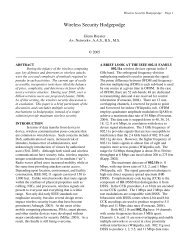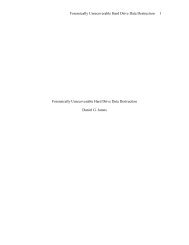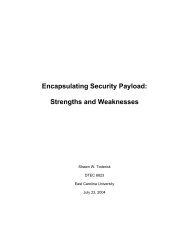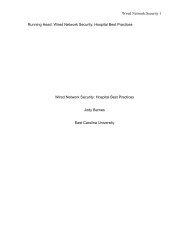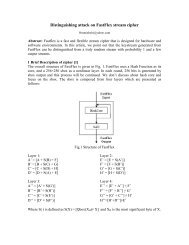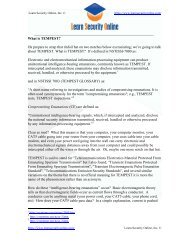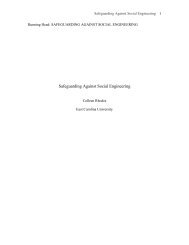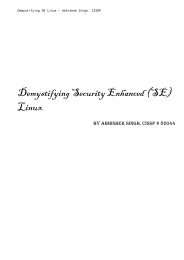Data security through obscurity - Rootsecure.net
Data security through obscurity - Rootsecure.net
Data security through obscurity - Rootsecure.net
Create successful ePaper yourself
Turn your PDF publications into a flip-book with our unique Google optimized e-Paper software.
3. For other iterations,<br />
i. the current plain text<br />
block is XOR ed with the<br />
previous cipher text block<br />
to generate the current<br />
cipher text block.<br />
ii. Initialization vector is set<br />
to the current cipher text<br />
block.<br />
4.2. Embed data in an image: Image<br />
steganography:<br />
Before proceeding into the algorithm, a<br />
small note on how images are stored into files.<br />
To a computer, an image is an array of numbers<br />
that represent light intensities at various points,<br />
or pixels. These pixels make up the image’s<br />
raster data. An image size of 640 x 480 pixels,<br />
utilizing 256 colours (8 bits per pixel) is fairly<br />
common. Digital images are typically stored in<br />
either 24-bit or 8-bit per pixel files. 24-bit<br />
images are known as true colour images.<br />
Obviously, a 24-bit image provides more space<br />
for hiding information; however, a 24-bit images<br />
are generally large and not that common. A 24-<br />
bit image 1024 pixels wide by 768 pixels high<br />
would have a size in excess of 2MB.<br />
Alternatively, 8-bit colour images can be used to<br />
hide information. In 8-bit colour images, each<br />
pixel is represented as a single byte. Each pixel<br />
merely points to a colour index table, or palette,<br />
with 256 possible colours. The pixel’s value ,<br />
then, is between 0 and 255. The image software<br />
merely needs to paint the indicated colour on the<br />
screen at the selected pixel position.<br />
Image compression:<br />
Image compression offers a solution to<br />
large image files. Two kinds of image<br />
compression are lossless and lossy<br />
compression. Both methods save storage space<br />
but have differing effects on any uncompressed<br />
hidden data in the image.<br />
Lossy compression, as typified by jpeg format<br />
files, offers high compression, but may not<br />
maintain the original image’s integrity. This can<br />
impact negatively on any hidden data in the<br />
image. This is due to the lossy compression<br />
algorithm, which may lose unnecessary image<br />
data, providing a close approximation to high<br />
quality digital images, but not an exact duplicate.<br />
Hence, the term lossy compression. Lossy<br />
compression is frequently used on true-colour<br />
images, as it offers high compression rates.<br />
Lossless compression maintains the original<br />
image data exactly: hence it is preferred when<br />
the original information must remain intact. It is<br />
thus more favoured by steganographic<br />
techniques. Unfortunately, lossless compression<br />
does not offer such high compression rates as<br />
lossy compression. Typical examples of lossless<br />
compression formats are GIF, BMP and PCX.<br />
This algorithm hides the encrypted file<br />
into a carrier medium.(The image file which<br />
carries the encrypted data),using the least<br />
significant bit insertion technique. The stego<br />
medium may be any image file compressed with<br />
lossless compression. The message is hidden<br />
into the LSBs of the image file. This algorithm<br />
handles the carrier file in a much careful way,<br />
since a very small change in the stego file, which<br />
is noticeable, will reveal the fact that it contains<br />
some data.<br />
Least significant bit insertion:<br />
The least significant bit insertion method is<br />
probably the most well known image<br />
steganography technique. It is a common,<br />
simple approach to embed information in a<br />
graphical image file. Unfortunately, it is<br />
extremely vulnerable to attacks, such as image<br />
manipulation. A simple conversion from a GIF<br />
or BMP format to a lossy compression format<br />
such as JPEG can destroy the hidden information<br />
in the image. When applying LSB techniques to<br />
each bytes of a 8-bit image, one bit can be<br />
encoded to each pixel. Any changes in the pixel<br />
bits will be indiscernible to the human eye. The<br />
main advantage of LSB insertion is that data can<br />
be hidden in the least and second to least bits and<br />
still the human eye would be unable to notice it.<br />
Care needs to be taken in the selection of the<br />
cover image, so that changes to the data will not<br />
be visible in the stego-image.<br />
4.3.Multi-level securities proposed in the<br />
algorithm:<br />
i.. To hide a text into the image:<br />
1. Apply encryption algorithm. This<br />
algorithm encrypts the text with a<br />
strong block cipher mechanism by<br />
applying the cipher block-chaining<br />
mode. It also provides the password<br />
protection.<br />
2. The cipher text file is embedded into<br />
the stego medium<br />
ii.To extract a text from the image:<br />
1. By extracting the LSBs from the stego<br />
image, a file containing cipher text is<br />
obtained.<br />
2. This file is decrypted using the<br />
encryption algorithm to get the original<br />
file.<br />
5



